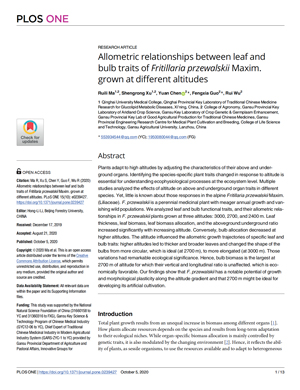NEWS 2020
Allometric relationships between leaf and bulb traits of Fritillaria przewalskii Maxim. grown at different altitudes
Ruili MA1,2, Shengrong XU1,2, Yuan CHEN2, Fengxia GUO2, Rui WU2
PLoSONE 15(10):e0239427 (2020)
https://doi.org/10.1371/journal.pone.0239427
1Qinghai University Medical College, Qinghai Provincial Key Laboratory of Traditional Chinese Medicine Research for Glucolipid Metabolic Diseases, Xi0ning, China
2College of Agronomy, Gansu Provincial Key Laboratory of Aridland Crop Science, Gansu Key Laboratory of Crop Genetic & Germplasm Enhancement, Gansu Provincial Key Lab of Good Agricultural Production for Traditional Chinese Medicines, Gansu Provincial Engineering Research Centre for Medical Plant Cultivation and Breeding, College of Life Science and Technology, Gansu Agricultural University, Lanzhou, China
Abstract
Plants adapt to high altitudes by adjusting the characteristics of their above and underground organs. Identifying the species-specific plant traits changed in response to altitude is essential for understanding ecophysiological processes at the ecosystem level. Multiple studies analyzed the effects of altitude on above and underground organ traits in different species. Yet, little is known about those responses in the alpine Fritillaria przewalskii Maxim. (Liliaceae). F. przewalskii is a perennial medicinal plant with meager annual growth and vanishing wild populations. We analyzed leaf and bulb functional traits, and their allometric relationships in F. przewalskii plants grown at three altitudes: 3000, 2700, and 2400 m. Leaf thickness, leaf biomass, leaf biomass allocation, and the aboveground:underground ratio increased significantly with increasing altitude. Conversely, bulb allocation decreased at higher altitudes. The altitude influenced the allometric growth trajectories of specific leaf and bulb traits: higher altitudes led to thicker and broader leaves and changed the shape of the bulbs from more circular, which is ideal (at 2700 m), to more elongated (at 3000 m). Those variations had remarkable ecological significance. Hence, bulb biomass is the largest at 2700 m of altitude for which their vertical and longitudinal ratio is unaffected. which is economically favorable. Our findings show that F. przewalskii has a notable potential of growth and morphological plasticity along the altitude gradient and that 2700 m might be ideal for developing its artificial cultivation.




